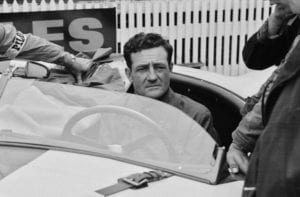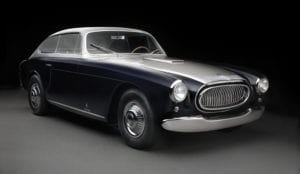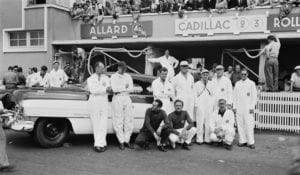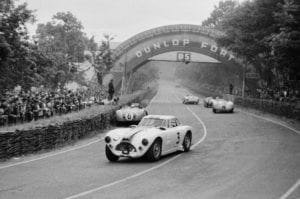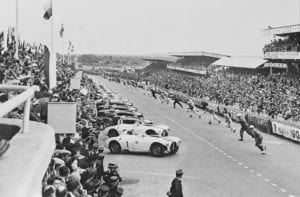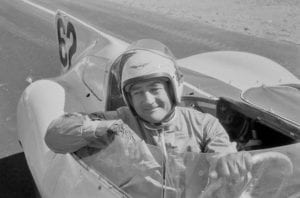Cunningham Didn’t Win Le Mans, But He Won Admiration and Affection
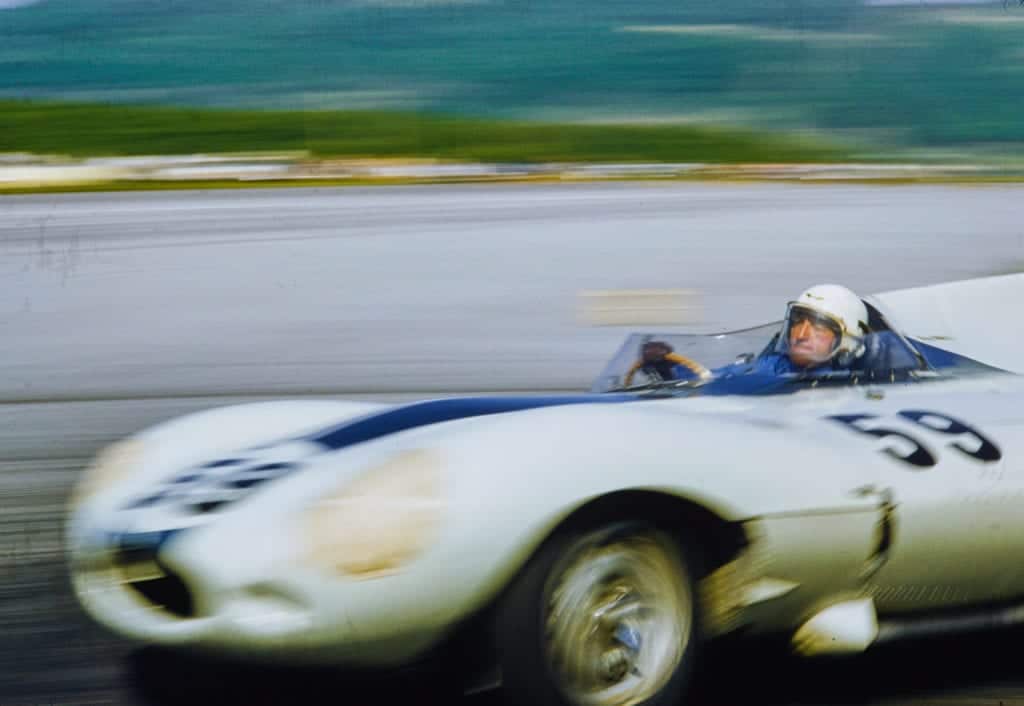
It was 1954. On April 12 the cover of Time magazine depicted a mushroom cloud under the headline “H-Bomb over Pacific,” describing America’s test of the first hydrogen bomb. Other Time covers that year showed Sen. Joseph McCarthy, Dr. Jonas Salk, Ernest Hemingway, Marlon Brando and Ho Chi Minh.
Also among them was Briggs S. Cunningham Jr. The S, appropriately, stood for “Swift.”
Briggs Cunningham in his Cunningham C-2R at the 1951 24 Hours of Le Mans. Photo: Rodolfo Mailander“Cunningham is the ranking figure in the whole throbbing, racketing U.S. preoccupation with motor cars and engines,” gushed the Time cover story of April 26, titled: “Millionaire at High Speed.” With Cunningham’s American-built cars preparing to tackle Europe’s pedigreed marques at LeMans two months hence, Time added: “To hundreds of thousands of U.S. speed fans, he is the symbol of all their own sporty urges, the man who makes fast cars and races them with the best at home and abroad.”
This weekend’s Concours d’Elegance in Greenwich, Conn. will feature the first (and perhaps last) gathering of all the 27 Cunningham C-3 models ever built. With bodies by Italian coachbuilder Vignale, the C-3s — built between 1952 and 1954 as road cars, not racers — were honored by New York’s Museum of Modern Art for exemplary design. That all 27 C-3s have survived to appear in one show is an automotive miracle.
The 1952 Cunningham C-3 from the Miles Collier Collection. Photo: Peter HarholdtSo is the fact that Briggs Cunningham holds a special place in the annals of American automobile racing. He was a good driver himself, but not among the very best. He never developed a sustainable, niche car company such as McLaren. The most creative period of his 96-year life lasted just over a decade.
And ultimately he failed to beat the Europeans at LeMans with American cars driven by American drivers, despite spending an estimated $10 million on the quest, equivalent to about $90 million today. “It was a prodigious sum,” wrote one journalist of the day, “and it could have only been expended by a millionaire with more courage than common sense.”
But Cunningham did show that Americans could be formidable road-racing competitors in Europe. His quest during the 1950s inspired then-young American drivers Dan Gurney and Phil Hill, who eventually did win at LeMans. And in the era of U.S. geo-political primacy that spawned the 1958 novel “The Ugly American,” Cunningham’s self-effacing-but-determined manner won affection from the racing fanatics of France, Britain, Germany and Italy.
“Almost uniquely, Briggs brought to motor racing the Corinthian ideal of sportsmanship,” says Miles Collier, founder of Revs Institute of Naples, Fl., whose father and uncle raced for Cunningham, and who himself purchased Cunningham’s personal car collection (including a 1952 C-3) to form the core of the Collier Collection at Revs. “There was no big money in it. There was no ulterior motive; just the strength of his affection for the sport.”
Adds Collier, grand marshal of this year’s Greenwich Concours: “It was David vs. Goliath, one guy from Westport, Conn. taking on the might of Jaguar, Mercedes-Benz, Ferrari and all the rest of them. He did it with impeccable demeanor, though he was a fierce competitor. That’s the apotheosis of the Corinthian ideal.”
Team Cunningham in the pits of the 1950 24 Hours of Le Mans. From Left to Right: Jean Oliveau, team member (glasses, shirt/tie, coverall, standing), Sam Collier, driver (hat, sunglasses, coverall, standing), Miles Collier, driver (watch on left wrist, coverall, standing), Bill Spear, team member (hat, glasses, standing), Phil Walters, driver (dark shirt/trousers, kneeling), Briggs Cunningham, driver (dark shirt, light trousers, kneeling), Alec Ulmann, team member (watch on left wrist, coverall, kneeling). Photo: Smith Hempstone OliverSimilar sentiment was expressed some 30 years ago by Denise McCluggage, herself a race driver as well as journalist and author, in an article for AutoWeek: “It’s as if (Cunningham) believed all those prep-school playing-field postulates about fairness, sportsmanship and How You Play the Game.”
Cunningham was born in Cincinnati in 1907. His banker-businessman father, Briggs Sr., co-founded the local phone company and helped fund the soap manufacturer that became Procter and Gamble.
Young Briggs attended Yale for a couple years before dropping out and marrying a Standard Oil heiress. They honeymooned across Europe, partied in Nice and Monaco, and raced sailboats on the Riviera with the king of Denmark and other glitterati. Sailing was Cunningham’s first passion, but after attending the 1930 automotive Grand Prix at Monaco he began turning to cars.
Americans had raced sparingly before World War II at the 24 Hours of Le Mans. When the race was resumed in 1949 — lifting the spirits of post-war France — Cunningham “began to dream about the challenge of going after the 24 Hours with American drivers in American cars,” he would tell Dean Batchelor and Albert Bochroch, two of his biographers.
American cars of the 1950s were utterly unsuited for European racing. They lumbered through curves with large-displacement engines powering their considerable weight. Europe’s light, agile roadsters ran and won on small, sophisticated engines. In 1950 Cunningham wanted to race at LeMans with a Ford coupe powered by a V8 Cadillac engine — dubbed the “Fordillac” — but the race authorities said it violated the rule against non-production cars.
So he came to LeMans with two V8 powered Cadillacs that embodied every European stereotype about America. One was a stock Cadillac Series 61 coupe with a few tweaks (e.g. an extra gas tank and a two-way radio). The other was a customized Series 61 with a massive, rectangular body designed by a Grumman aircraft engineer to reduce wind resistance. The French dubbed it “Le Monstre.”
The 1950 Cadillac Series 61 “Le Monstre” from the Miles Collier Collection. Photo: Peter HarholdtThe coupe was piloted by Sam and C. Miles Collier (uncle and father of the founder of Revs), who explained they raced with jackets and ties because they always dressed that way for work. Their car finished a very respectable 10th among 60 entrants. Le Monstre, driven by Phil Walters and Cunningham himself, finished 11th.
The French were smitten, and Cunningham was bitten. He returned home to West Palm Beach to set up a small factory to design and produce cars that could win. When Cadillac stopped supplying him with engines, Cunningham used old-school ties (a Yale friend was the son of Chrysler’s president) to procure Chrysler Hemi V8s. Tragedy struck that fall when Sam Collier, age 38, was killed driving Cunningham’s Ferrari 166 at Watkins Glen. Cunningham was disconsolate.
After a so-so 1951 LeMans showing with the C-2Rs (R for Racing), a Cunningham C-4R finished fourth in 1952, behind two Mercedes-Benzes and a Nash-Healey. The C-4R’s 5.4-liter Chrysler V8 was easily the largest engine among the top 10 finishers. Briggs himself drove a 19 ½-hour stretch at the end to finish the race, because he worried that a slipping clutch would ground the car if he stopped.
America was competitive thanks to Cunningham’s determination and deep pockets, though he watched expenses closely. “If you will stop to consider the money that is being spent…,” he admonished his team in a memo that’s in the Revs library’s Cunningham papers, “I am sure you will agree that a very businesslike or even military type organization is justified.” Cunningham tracked accounting for components that cost just 76 cents.
In 1953 Jaguar took three of the first four places, including first and second, with its legendary C-Types and their 3.4-liter engines. But the Cunninghams, with their 5.4-liter Chrysler V8s, copped three of the top 10 places: third, seventh (with Briggs and John Spear driving) and 10th. It was a two-team showdown at the 24-hour circuit. The outcome was determined not by the engines but by the brakes.
The Cunningham C-4RK at the 1953 24 Hours of Le Mans, where it would finish 10th. Photo: Rodolfo MailanderThe Cunninghams passed the Jaguars on straightaways, but the dark green Jags overcame them on the curves. Dunlop disc brakes allowed the Jaguars to out-brake the Cunninghams into the corners and achieve faster exit speed.
Having his faster cars beat by brakes, of all things, put Cunningham in high dudgeon. He dispatched driver and team manager Phil Walters to Coventry to procure Dunlop’s disc brakes for his own cars. Dunlop officials initially agreed but then reneged, stiffing the American upstart for Queen and country.
Still, after Team Cunningham’s 1953 bravura performance at LeMans (and at Riverside, Watkins Glen and Sebring in America), expectations ran high for the 24-hour race of 1954. The Time cover story touted America’s high hopes.
In the event, Briggs fell just short again. His two Cunningham C-4Rs finished third and fifth, with Briggs himself co-piloting the fifth-place car. Scuderia Ferrari’s 375 Plus won with a 4.9 -liter V12.
The start of the 1954 24 Hours of Le Mans, with the Cunningham C-4R, number 1, of Briggs Cunningham and John Gordon Bennett, on pole position as the race starts and the drivers run to their cars. Photo: Albert R. Bochroch.It would be Cunningham’s high-water mark at LeMans. He raced in 1955, when a horrific crash (he wasn’t involved) killed 80 spectators. In 1956 he stopped building cars because he had never produced a profit, causing America’s tax authorities to declare his factory a hobby instead of a business and thus rendering it financially unviable. He became Jaguar’s distributor for the northeast U.S. — thus representing his erstwhile rival — and started racing Jags. He withdrew from his quest to win at LeMans, but not from sporting competition.
When the America’s Cup yacht race decided to resume in 1958, after a 25-year hiatus, Cunningham was approached by the New York Yacht Club to help finance a new boat, the Columbia, and to serve as its skipper-helmsman. Cunningham returned to his first sport. The Americans won four straight races at Newport, R.I., and sent England’s vanquished Sceptre home.
At the victory celebration Cunningham found a pay phone, called friends at Watkins Glen and learned that Eddie Crawford had just won the Grand Prix in a Cunningham-entered car. When he returned to the yachting party, Batchelor and Bochroch recounted in their biography, someone said, “Briggs, that was a fine race.” The man was mystified when Cunningham, still thinking of Watkins Glen, replied: “That’s what I just heard. I wish I could’ve seen it.”
Briggs Cunningham in his 1955 Jaguar D-Type at the SCCA Bridgehampton National Championship Races in 1957. Photo: Tom BurnsideAnother story, perhaps apocryphal, spotlights Cunningham’s self-effacing personality. At cocktail parties — he had to host many, despite being a teetotaler — Briggs sometimes would ask a friend to drop a glass, deliberately, onto the floor. Then he would fetch broom and dustpan and sweep up with slow deliberation, affording him a brief respite from the ambient high-decibel chatter.
In 1960, when Cunningham returned to race at LeMans, the city fathers named him a Citoyoen d”Honneur de la Ville, showing their respect and affection. During the next four years he never won, but each year he placed at least one car in the top 10.
He did it with the improvisational derring-do French fans loved. One of his Chevrolet Corvettes placed eighth in 1960 after the engine compartment was packed with ice to prevent overheating. In 1963 a Cunningham Jaguar finished ninth after crashing and being rebuilt in the pits in just 74 minutes.
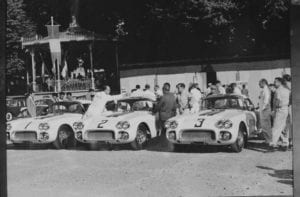
In all, Cunningham had placed well in seven of the 10 years he had raced at LeMans. Apres’ Briggs, competitive American cars at LeMans were no longer a curiosity.
Meanwhile Cunningham was divorced, remarried and moved to southern California with his new wife. He opened the Cunningham Automotive Museum — displaying his racers and other cars — at Baker Street and Red Hill Road in Costa Mesa in 1966. That year Ford’s GT Mark II became the first American winner at LeMans. “Although I couldn’t help but wish it was a Cunningham,” Briggs declared, “I was very pleased when Ford won in 1966. It was time for an American car to join the great makes that had won the 24 hour.”
But Ford’s winning drivers were New Zealanders, not Americans. “It was not until 1967,” Cunningham later explained, “when Dan Gurney and A.J. Foyt won with their Ford Mark IV, that my goal was reached.” American car, American drivers.
His LeMans quest “just got to be an obsession with me,” Cunningham explained to an interviewer in 1987. “I don’t know why, any more than why anyone wants to win Wimbledon. I wasn’t too keen on the short races. I just loved long-distance races where you could sit there and drive for four hours, taking it easy with the car. Other guys would overdo things and have to drop out. You just always survive.”
So do, today, the cars and legacy of Briggs Cunningham. In 1993 he was inducted into the America’s Cup Hall of Fame. A decade later he died in Las Vegas, the final place he called home, just months after being elected to the Motor Sports Hall of Fame.
